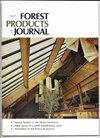Wood Vinegars: Production Processes, Properties, and Valorization
IF 1.2
4区 农林科学
Q3 FORESTRY
引用次数: 0
Abstract
Pyrolysis of lignocellulosic biomass is widely used for the production of charcoal, pyroligneous liquid, and noncondensable gases. All three are value-added products that are exploited in several fields. However, this review focuses on three main areas: wood vinegar production methods, its physicochemical properties, and the use of wood vinegar or pyroligneous acid in agriculture and the environment. Wood vinegar is a liquid derived from wood by the condensation of gases and vapors released during the carbonization process, which is the transformation of wood into charcoal. It is mainly composed of aliphatic, aromatic, and naphthenic hydrocarbons and other oxygenated compounds such as alcohols, aldehydes, ketones, furans, acids, phenols, and ethers. Wood vinegar has antioxidant and free-radical-scavenging properties and is used in agriculture as an antimicrobial, antifungal, insecticide, and plant germination and growth agent. It is also used in food preservation, in medicine, and in the ecological preservation of wood. This review also examines the state of the art in pyroligneous liquid production techniques and factors that could potentially affect its quality.木Vinegars:生产工艺、特性和Valorization
木质纤维素生物质的热解广泛用于生产木炭、热木质液体和不凝气体。这三种产品都是在多个领域开发的增值产品。然而,这篇综述集中在三个主要领域:木醋的生产方法、其物理化学性质,以及木醋或木脂酸在农业和环境中的应用。木醋是由木材在碳化过程中释放的气体和蒸汽冷凝而成的液体,碳化过程是将木材转化为木炭。它主要由脂肪族、芳香族和环烷烃以及其他含氧化合物组成,如醇、醛、酮、呋喃、酸、酚和醚。木醋具有抗氧化和清除自由基的特性,在农业中用作抗菌、抗真菌、杀虫剂以及植物发芽和生长剂。它还用于食品保鲜、医药和木材的生态保护。这篇综述还考察了木脂液体生产技术的现状以及可能影响其质量的因素。
本文章由计算机程序翻译,如有差异,请以英文原文为准。
求助全文
约1分钟内获得全文
求助全文
来源期刊

Forest Products Journal
工程技术-材料科学:纸与木材
CiteScore
2.10
自引率
11.10%
发文量
30
审稿时长
6-12 weeks
期刊介绍:
Forest Products Journal (FPJ) is the source of information for industry leaders, researchers, teachers, students, and everyone interested in today''s forest products industry.
The Forest Products Journal is well respected for publishing high-quality peer-reviewed technical research findings at the applied or practical level that reflect the current state of wood science and technology. Articles suitable as Technical Notes are brief notes (generally 1,200 words or less) that describe new or improved equipment or techniques; report on findings produced as by-products of major studies; or outline progress to date on long-term projects.
 求助内容:
求助内容: 应助结果提醒方式:
应助结果提醒方式:


